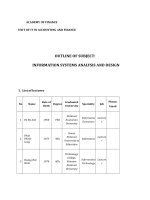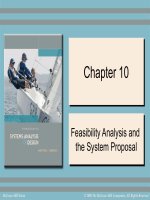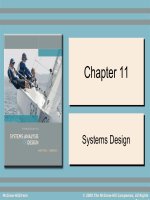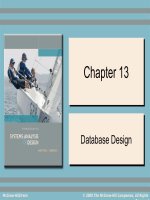Systems analysis and design methods 7th by whitten bentley chap06
Bạn đang xem bản rút gọn của tài liệu. Xem và tải ngay bản đầy đủ của tài liệu tại đây (734.82 KB, 50 trang )
Chapter 6
Fact-Finding
Techniques for
Requirements
Discovery
McGraw-Hill/Irwin
Copyright © 2007 by The McGraw-Hill Companies, Inc. All
Objectives
• Define system requirements and differentiate between
functional and nonfunctional requirements.
• Understand the activity of problem analysis and be
able to create an Ishikawa (fishbone) diagram.
• Understand the concept of requirements management.
• Identify and characterize seven fact-finding techniques.
• Understand six guidelines for effective listening.
• Understand body language and proxemics.
• Characterize the typical participants in a JRP session.
• Complete the planning process for a JRP session.
• Describe benefits of JRP as fact-finding technique.
• Describe a fact-finding strategy that will make the most
of your time with end-users.
6-2
6-3
Introduction to Requirements
Discovery
Requirements discovery – the process
and techniques used by systems analysts
to identify or extract system problems and
solution requirements from the user
community.
6-4
System requirement – something that
the information system must do or a
property that it must have. Also called a
business requirement.
Functional vs. Nonfunctional
Requirements
Functional requirement - something the
information system must do
Nonfunctional requirement - a property
or quality the system must have
• Performance
• Security
• Costs
6-5
Results of Incorrect
Requirements
6-6
• The system may cost more than projected.
• The system may be delivered later than
promised.
• The system may not meet the users’
expectations and they may not to use it.
• Once in production, costs of maintaining and
enhancing system may be excessively high.
• The system may be unreliable and prone to
errors and downtime.
• Reputation of IT staff is tarnished as failure will
be perceived as a mistake by the team.
Relative Cost to Fix an Error
6-7
Criteria for System
Requirements
6-8
• Consistent – not conflicting or ambiguous.
• Complete – describe all possible system
inputs and responses.
• Feasible – can be satisfied based on the
available resources and constraints.
• Required – truly needed and fulfill the purpose
of the system.
• Accurate – stated correctly.
• Traceable – directly map to functions and
features of system.
• Verifiable – defined so can be demonstrated
during testing.
Process of Requirements
Discovery
• Problem discovery and analysis
• Requirements discovery
• Documenting and analyzing
requirements
• Requirements management
6-9
Ishikawa Diagram
• Graphical tool used to identify, explore, and depict
problems and the causes and effects of those
problems. It is often referred to as a cause-and-effect
diagram or a fishbone diagram.
• Problem at right (fish head)
• Possible causes drawn as "bones" off main backbone
• Brainstorm for 3-6 main categories of possible causes
6-10
Requirements Discovery
• Given an understand of problems, the systems
analyst can start to define requirements.
Fact-finding – the formal process of using
research, meetings, interviews, questionnaires,
sampling, and other techniques to collect
information about system problems,
requirements, and preferences. It is also called
information gathering or data collection.
6-11
Documenting and Analyzing
Requirements
• Documenting the draft requirements
• Use cases
• Decision tables
• Requirements tables
• Analyzing requirements to resolve problems
•
•
•
•
•
Missing requirements
Conflicting requirements
Infeasible requirements
Overlapping requirements
Ambiguous requirements
• Formalizing requirements
6-12
• Requirements definition document
• Communicated to stakeholders or steering body
Requirements Definition
Document
Requirements Definition Document – A formal
document that communicates the requirements
of a proposed system to key stakeholders and
serves as a contract for the systems project.
• Synonyms
•
•
•
•
6-13
Requirements definition report
Requirements statement
Requirements specification
Functional specifications
Sample Requirements
Definition Report Outline
6-14
Requirements Management
Requirements management - the process of
managing change to the requirements.
• Over the lifetime of the project it is very common for
new requirements to emerge and existing
requirements to change.
• Studies have shown that over the life of a project as
much as 50 percent or more of the requirements will
change before the system is put into production.
6-15
Fact-Finding Ethics
• Fact-Finding often brings systems analysts into contact
with sensitive information.
• Company plans
• Employee salaries or medical history
• Customer credit card, social security, or other information
• Ethical behavior
• Systems analysts must not misuse information.
• Systems analysts must protect information from people who
would misuse it.
• Otherwise
6-16
• Systems analyst loses respect, credibility, and confidence of
users and management, impairing ability to do job
• Organization and systems analyst could have legal liability
• Systems analyst could lose job
Seven Fact-Finding Methods
• Sampling of existing documentation,
forms, and databases.
• Research and site visits.
• Observation of the work environment.
• Questionnaires.
• Interviews.
• Prototyping.
• Joint requirements planning (JRP).
6-17
Sampling Existing
Documentation, Forms, & Files
Sampling –process of collecting a representative
sample of documents, forms, and records.
6-18
• Organization chart
• Memos and other documents that describe the
problem
• Standard operating procedures for current system
• Completed forms
• Manual and computerized screens and reports
• Samples of databases
• Flowcharts and other system documentation
• And more
Things to be Gleaned from
Documents
• Symptoms and causes of problems
• Persons in organization who have
understanding of problem
• Business functions that support the
present system
• Type of data to be collected and reported
by the system
• Questions that need to be covered in
interviews
6-19
Why to Sample Completed
Rather than Blank Forms
• Can determine type of data going into each blank
• Can determine size of data going into each blank
• Can determine
which blanks
are not used
or not always
used
• Can see data
relationships
6-20
Determining Sample Size for
Forms
• Sample Size = 0.25 x (Certainty factor/Acceptable error)
• Sample Size = 0.25(1.645/0.10) 2 = 68
• Sample Size =0.10(1 – 0.10)(1.645/0.10)2 = 25
Or if analyst
knows 1 in 10
varies from norm.
6-21
Certainty factor from
certainty table. 10%
acceptable error.
2
Sampling Techniques
Randomization – a sampling technique
characterized by having no predetermined
pattern or plan for selecting sample data.
Stratification – a systematic sampling
technique that attempts to reduce the
variance of the estimates by spreading out the
sampling—for example, choosing documents
or records by formula—and by avoiding very
high or low estimates.
6-22
Observation
Observation – a fact-finding technique wherein
the systems analyst either participates in or
watches a person perform activities to learn
about the system.
Advantages?
Disadvantages?
Work sampling - a fact-finding technique that
involves a large number of observations taken
at random intervals.
6-23
Observation
6-24
Advantages
Disadvantages
• Data gathered can be
very reliable
• Can see exactly what is
being done in complex
tasks
• Relatively inexpensive
compared with other
techniques
• Can do work
measurements
• People may perform
differently when being
observed
• Work observed may not
be representative of
normal conditions
• Timing can be
inconvenient
• Interruptions
• Some tasks not always
performed the same
way
• May observe wrong
way of doing things
Observation Guidelines
6-25
• Determine the who, what, where, when, why, and
how of the observation.
• Obtain permission from appropriate supervisors.
• Inform those who will be observed of the purpose
of the observation.
• Keep a low profile.
• Take notes.
• Review observation notes with appropriate
individuals.
• Don't interrupt the individuals at work.
• Don't focus heavily on trivial activities.
• Don't make assumptions.









